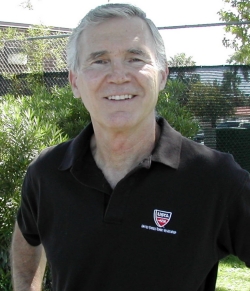Posted Apr 10, 2007
By Jeff Brack
April 2007

Jim Reffkin – Tennis Innovator from Tucson, AZ
Unfortunately, the contributions of pioneers are usually recognized long after they have left us. Due credit is rarely received in their own time.
That very rare occasion occurred this past March at the 2007 National USTA Annual Meeting. Kurt Kamperman, the Chief Executive of Community Tennis Development for the United States Tennis Association, stood before the crowded general assembly of tennis volunteers and staff from around the country and told the story of how a great innovator of our game or “future chef” suggested that change and adaptation were necessary for tennis to survive, and we threw him out of the kitchen.
In 1988, when Jim Reffkin, then the National President of the USPTA, addressed the grand assembly of teaching professionals for his outgoing speech, he passionately decried the declining participation in tennis and suggested that changes were a necessary piece of the retention puzzle. Unknown to many, the next part is now tennis history. Reffkin simply stated that replacing the third set with a tiebreak was imperative. Streamlining our scoring system would provide many benefits that would not only make tennis more attractive for growing the game, but provide more options for retaining time-poor adults, young juniors and aging seniors. Tournament and league competitions would be time-definable, run smoothly, and the athletes would be able to avoid early round marathons and save their best tennis for last. When he finished, only the crickets chirped.
How did he come to this conclusion? After years of watching his events careen off schedule, tenacious competitors finish remarkable third set matches only to be crushed next round by a fresher, less taxed player, parents’ faces as they realized that their evening plans were shot because their child’s 2:00 match would be at 5:00 and young juniors staggering off the court not knowing which way was up, he could see them slipping away. Their expressions said it all, “Why am I doing this?”
Match Tiebreak (in lieu of third set) was indeed the brain child of Jim Reffkin and will undoubtedly be one of his greatest contributions to the sport of tennis. The impact of his scoring revolution has not yet run its full course, but to date it has been adopted by the ATP & WTA for all professional doubles, the USTA, ITF (International Tennis Federation), NCAA, High School, Tennis Australia, and the US Open & Australian Open Mixed Doubles. Television now carries more doubles matches (being time-definable), more top ranked singles professionals are playing doubles, young junior competitors are now competing in matches of an appropriate length, tennis tournaments run on schedule and one-day formats have thrived.
When Kamperman publicly acknowledged the tremendous service that Reffkin has provided, by not only suggesting groundbreaking changes, but for his willingness to face the adversity of traditionalists and boldly pilot new formats at his own facility, he brought a sense of accomplishment that many never experience. Through years of work with many associations worldwide, the Collegiate doubles format 8-GAME PRO SET, Super Scoring or MATCH TIEBREAK in Lieu of Third Set, and one-day SHOOTOUTS and SUPERSETS are all possible due to the relentless persistence of a “future chef” from Tucson, Arizona.
The theme for the entire USTA Annual Meeting was “Future Ready,” and having it take place in Tucson could not have been more appropriate. The energy and enthusiasm was at a fevered pitch for making our game RELEVENT in an evolving culture. Innovation was everywhere, from foam ball tennis on reduced-sized courts for beginners to workshops on thinking “outside the box.” A keynote speaker even proposed the question, “If tennis had never existed, and was invented today, would it be the same?”
It has been a long road of successes and failures for a man with a vision for making tennis available to everyone – for winning back those athletes we lose to other sports – for keeping those that give us a try. All were quiet in 1988 when he shared that vision, but on Sunday, March 25, 2007, those cricket chirps turned to applause.



